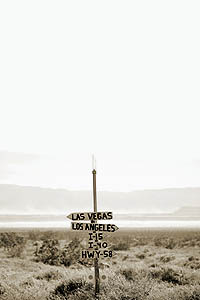
Not to be outdone, the local water authority promises cheap water in the middle of a scorching desert. Try to figure this out: A family of four in Las Vegas pays $1 a day for 400 gallons of water; a family of four in Atlanta—with 13 times the precipitation—pays $2 for the same amount of water.
While most big cities sit on the banks of a river, lake, or ocean, bone-dry Las Vegas owes its existence to the Hoover Dam, 34 miles away. The dam is the source of cheap water and power. Without the one, the myriad of fountains along the Strip would cease to dance, the 60 golf courses would wither, and thousands of pools would no longer fill. Without the other, the lights would dim, and the air conditioners would stop humming. In the words of one official, the sprawling metro area of 2 million people would revert to “a place of sand dunes, mosquitoes and rattlesnakes.”
Originally, it was thought that Mormon farmers would use the Colorado River water captured by the dam to create a smaller version of California’s Imperial Valley. That is not what happened. Instead, when work on the dam began in 1931, the city filled with a rowdy army of construction workers. Their employer, the U.S. Bureau of Reclamation, “invented modern Las Vegas.” As Emily Green of the Las Vegas Sun tells the story: “[The workers’] needs could be largely summed up in a telephone book under B: boarding houses, brothels and bars. Moreover, that same year, Nevada legalized gambling. Las Vegas added a C to its key services: casinos.”
No one expected the small number of people in and around Las Vegas at the time to pick up any portion of the capital cost of building the dam. Like other big Depression era projects, it was both launched and paid for by the federal government.
Three-quarters of a century later, a super-sized Las Vegas continues to rely on Lake Mead, behind the dam, for nearly 90 percent of its water. The water still costs very little. And the federal government continues to supply cutrate electricity—giving the city power at less than half the wholesale price.
Will Las Vegas ever outgrow the great store of water that makes the desert bloom and allows the lights to burn so brightly? The city’s water czars live in fear of that possibility. The Southern Nevada Water Authority (SNWA) and its smaller sister organization, the Las Vegas Valley Water District (LVVWD), have adopted a wide range of restrictions to limit water usage, including one that bans restaurants from serving unsolicited tap water. Upon visiting the water authority’s web site, one finds a list of restrictions:
- Sprinkler watering is prohibited from 11 a.m. to 7 p.m. (May through October).
- Mist systems at commercial businesses may not be used (September through May).
- Fountains are restricted at commercial and multi-family properties.
- New grass is prohibited at commercial properties and new residential front yards.
- Car washing requires the use of a positive shutoff nozzle to reduce water flow.
To enforce such regulations, LVVWD employs its own “water police” who go around town looking for violations. In 2009, the water police investigated more than 6,000 cases of wasteful water uses and issued nearly $100,000 in fines. Employing the carrot as well as the stick, the water authority pays homeowners up to $7,500 to rip out green lawns.
But it is the supply side rather than the demand side where the water authority hopes to hit it big. In October 1989, LVVWD applied for unclaimed groundwater in northeastern Nevada, with an estimated pull of as much as 800,000 acre-feet of water, or just about double the allocation from Lake Mead. To bring that water to Las Vegas would require a 300-mile pipeline.
There was fierce opposition from ranchers, farmers, environmental groups, and others in Nevada and Utah. The controversy continues today. Opponents say that pumping the aquifer beneath the Great Basin would turn a sparse but beautiful desert landscape into a giant dust bowl. They say it would kill plants and wildlife and recreate the disaster of California’s Owens Valley.
The controversy died down for a while as the water level at Lake Mead was rising — calming fears of water shortages and causing SNWA to table its plan. The lake reached an all-time high in 1998. But that was also the beginning of a 12-year drought, which caused the lake to fall below 50 percent of capacity. Suddenly, alarm bells were ringing inside the water authority. In 2008, it began to build a massive underground tunnel to assure its continued ability to suck water from the lake.
Now, SNWA and its supporters are demanding immediate action on the proposed pipeline, while opposition groups have become increasingly energized as well. SNWA admits that a near-doubling in water rates may be needed to finance the $7.2 billion project.
Here’s a proposal that the water authority seems not to have considered: Since water rates appear to be going up anyway, discard the historic cost-based pricing model and move instead to a pricing system that recognizes the scarcity value of water. Allow water rates to double or triple. Encourage free trading in water rights by homeowners and others. See if that doesn’t avert the need for any construction. Call this a market-ready—as opposed to a shovel-ready—solution.



